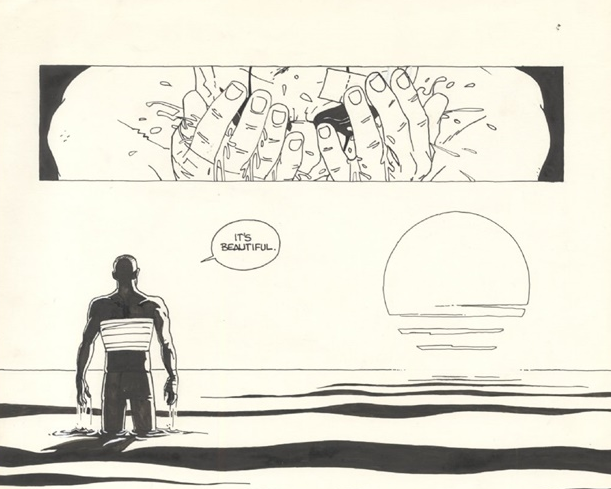It's the final two days for The Whole Story, where publisher Ryan Estrada provided seven books at a sliding scale price that turned into a "pay what you wish" opportunity. The chance to get any of these books, including the two reviewed here, ends on Monday, July 23rd.
As part of the Whole Story collection, web and mini-comic creator (as well as the publisher of the varied, quirky, and high-quality Retrofit Comics) Box Brown provided three books, collecting his web and print series Everything Dies. While I was not able to read all three books in time to review them, I did read two of them, A Heart of Stonework and Walk Like a Sumerian, and both of them were excellent comics that show Brown's range as a writer and are not to be missed, especially since you can get them (and 5 other books) for less than a dollar.
Despite having an irreverent nature, A Heart of Stonework is a work with a deep philosophical core. The stories collected here focus around a strange religious order that echos that of an Eastern religion, but the Master is one who comes from a life of great tragedy and pain. He is unsure of the nature of God, other than rejecting those whose faith is unwavering and hateful, and he passes that on to his followers. The nature of the tales and philosophy can be jarring and abrupt, but it captured my imagination and latent love of philosophy and held me right up until the very end.
I don't know how much of the beliefs expressed in this book relate to those of Brown himself, but they echo a lot of the ideas that often go through my head. I could easily relate to rejecting the faith of those who feel that their God protects only them and rejects any who are different. I understand a tragedy causing you to rethink everything, and the fear and pain and struggle that goes into finding a way in the world. Anyone who has wrestled with their faith in any way should really relate to A Heart of Stonework. It is very much a thinking person's comic, with layers of depth that the simplicity of the art belies.
Though Walk Like a Sumerian also deals with religion, the tone and topic are extremely different. This time around, a more playful Brown examines the Sumerian religion and picks out some of its more interesting stories to show the reader that the early days of any religion are filled with violence, treachery, and in one case, lots and lots of sex.
There are creation stories, a tale of a Flood that's going to seem awfully familiar to anyone who's ever read a Bible (though it has a happier ending for the builder of the Ark), and one that I cannot possibly figure out the moral to no matter how hard I try. Brown more or less plays them straight, allowing the weirdness of the stories to speak for themselves, though he's not above using a few visual tricks to emphasize just how odd some of these things are.
Perhaps because of the nature of the stories, Brown's art in Walk Like a Sumerian is stronger than in A Heart of Stonework. In both books, the focus is on the narrative and the characters. They are all drawn with strong, thick black outlines and basic features that are just enough for us to get an idea of the character, whether it's a monk with a moustache or a lustful god that has the build and look of a WWF wrestler. In terms of style, he reminds me a lot of Joey Weiser, though the figures are a bit more adult in nature and the themes are definitely far more mature than Weiser's all-ages appropriate work.
Brown's backgrounds are minimalist, providing just enough to set the scene. With the cosmic scope of the Sumerian stories, Brown is able to do a little Kirby Krackle here and there, which is fun to see through the lens of a artist who isn't trying to directly ape the style. Though the details are sparse, in both books, Brown is able to do amazing things with staging. He has an uncanny eye for panel placement, finding a way to draw the reader's eye to just the right thing at the right time. There are several cases in Walk Like a Sumerian where I paused just to admire how the page was designed. Working entirely in black and white, Brown uses the two colors in ways that evoke real emotion from the reader, just like Mike Mignola or Frank Miller.
I'm afraid of sounding insulting when I say this, but it really impresses me how Brown gets so much out of the basic linework he uses. There's more to his art in these simple strokes than in a complicated, over-drawn superhero comic. It's all in the application of style, and if these two books are any indication, Brown is a master at applying his talents to the work at hand.
Drawn together from mini-comics and webcomics, these two books show exactly why I am a fan of both. There are plenty of people who are doing great work in these areas under the radar. These collections are obviously a must-buy for anyone who likes Box Brown, but I'd also recommend them to anyone who is a fan of mythology or philosophy. They've definitely caused me to want to get more of Brown's work the next time I see him at a show. Best of all, right now, you can get both books for less than a dollar--but you need to do it by Monday. Don't get into a Socratic dialogue about this--just pick them up!
Footer Copyright
Design by - Blogger Templates | Distributed by Free Blogger Templates









